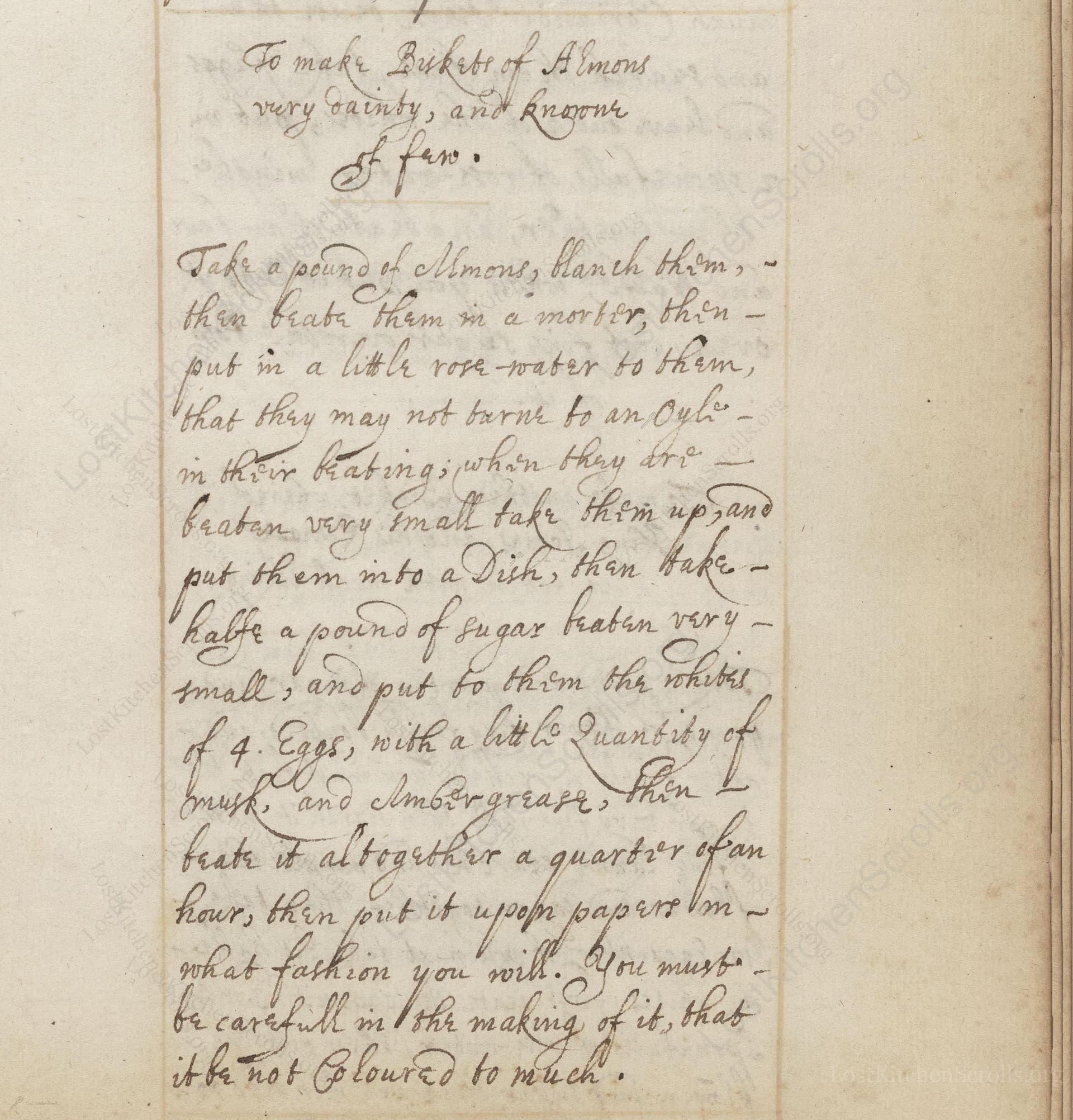To Make Biskets Of Almonds Very Dainty, And Good
From the treasured pages of Receipt book of Sarah Longe
Written by Sarah Longe

To Make Biskets Of Almonds Very Dainty, And Good
"Take a pound of Almonds, blanch them, - then beate them in a morter, then - put in a little rose-water to them, - that they may not turne to an Oylie - or their beating; when they are - beaten very small take them up, and put them into a Dish, then take - halfe a pound of sugar beaten very - small, and put to them the whites of 4. Eggs, with a little Quantity of musk, and Amber-grease, then I - beate it altogether a quarter of an hour, then put it upon papers in - what fashion you will. You must - be carefull in the making of it, that it be not coloured to much."
Note on the Original Text
The recipe, like most culinary instructions of its era, is written as a narrative rather than a precise set of steps. Quantities are provided for the main ingredients but smaller quantities—like flavorings—are left to discretion, reflecting the experienced cook's judgment. The spelling and capitalization vary ('Biskets', 'beate', 'Oylie'), and punctuation is sparse, as was customary. The lack of explicit temperature or timing information presumes familiarity with baking techniques of the period.

Title
Receipt book of Sarah Longe (1610)
You can also click the book image above to peruse the original tome
Writer
Sarah Longe
Era
1610
Publisher
Unknown
Background
A delightful glimpse into early 17th-century kitchens, this collection by Sarah Longe whisks readers through ancestral recipes, cooking tips, and the seasonings that graced the tables of Jacobean England. Prepare to savor the tastes and traditions of times gone by.
Kindly made available by
Folger Shakespeare Library
This recipe for almond biscuits dates from the early 17th century, around 1610, from the collection of Sarah Longe—a time when sugar and almonds were luxuries affordable mostly by wealthier households. The inclusion of musk and ambergris denotes a dish of special refinement, as these expensive aromatic ingredients were highly prized for their exotic perfume. Biskets of almonds were likely served as sweetmeats at banquets or gatherings, a time when sharing delicate confections signified status and worldliness.

Traditionally, this recipe would have been prepared using a large mortar and pestle to blanch and grind the almonds finely. Rose water would be made or purchased, and eggs might be separated by hand. Mixing was done in sturdy earthenware or wooden bowls, and the beating was a laborious task done with a spoon or hands for a prolonged period. The shaped biscuits were placed on sheets of paper or thin metal trays and baked in a wood-fired oven, with careful attention to avoid over-browning.
Prep Time
30 mins
Cook Time
20 mins
Servings
20
We've done our best to adapt this historical recipe for modern kitchens, but some details may still need refinement. We warmly welcome feedback from fellow cooks and culinary historians — your insights support the entire community!
Ingredients
- 1 pound blanched almonds
- 1 tablespoon rose water
- 8 ounces caster sugar
- 4 egg whites
- A pinch of musk powder (optional, substitute with a drop of edible floral essence or vanilla)
- A pinch of ambergris (optional, substitute with a drop of orange blossom or extra rose water)
Instructions
- Begin by taking 1 pound of blanched almonds (to blanch, pour boiling water over whole almonds, let them sit for a minute, then slip off the skins).
- Place the blanched almonds in a food processor or mortar and pestle, and grind them finely, adding a tablespoon of rose water to keep the paste from turning oily.
- Transfer the almond paste to a bowl.
- Add 8 ounces of finely ground caster sugar to the almonds.
- Lightly beat the whites of 4 medium eggs, then add to the almond-sugar mixture.
- Add a tiny pinch of powdered musk and ambergris if available, or allow a drop of edible floral essence or vanilla extract in their place (see substitutes below).
- Beat the mixture thoroughly by hand or with an electric mixer for a full 15 minutes, until light and aerated.
- Spoon or pipe small rounds onto baking parchment on a baking tray.
- Shape as desired, then bake at 300°F (fan 285°F) for about 15-20 minutes, or until just set and barely colored.
- Let cool before serving.
Estimated Calories
150 per serving
Cooking Estimates
It takes about 30 minutes to prepare the ingredients, including blanching and grinding the almonds and mixing the batter. Baking takes 20 minutes. Each serving contains about 150 calories, and the recipe makes 20 cookies.
As noted above, we have made our best effort to translate and adapt this historical recipe for modern kitchens, taking into account ingredients nowadays, cooking techniques, measurements, and so on. However, historical recipes often contain assumptions that require interpretation.
We'd love for anyone to help improve these adaptations. Community contributions are highly welcome. If you have suggestions, corrections, or cooking tips based on your experience with this recipe, please share them below.
Join the Discussion
Rate This Recipe
Dietary Preference
Main Ingredients
Culinary Technique

Den Bockfisch In Einer Fleisch Suppen Zu Kochen
This recipe hails from a German manuscript cookbook compiled in 1696, a time whe...

Die Grieß Nudlen Zumachen
This recipe comes from a rather mysterious manuscript cookbook, penned anonymous...

Ein Boudain
This recipe comes from an anonymous German-language manuscript cookbook from 169...

Ein Gesaltzen Citroni
This recipe, dating from 1696, comes from an extensive anonymous German cookbook...
Browse our complete collection of time-honored recipes



